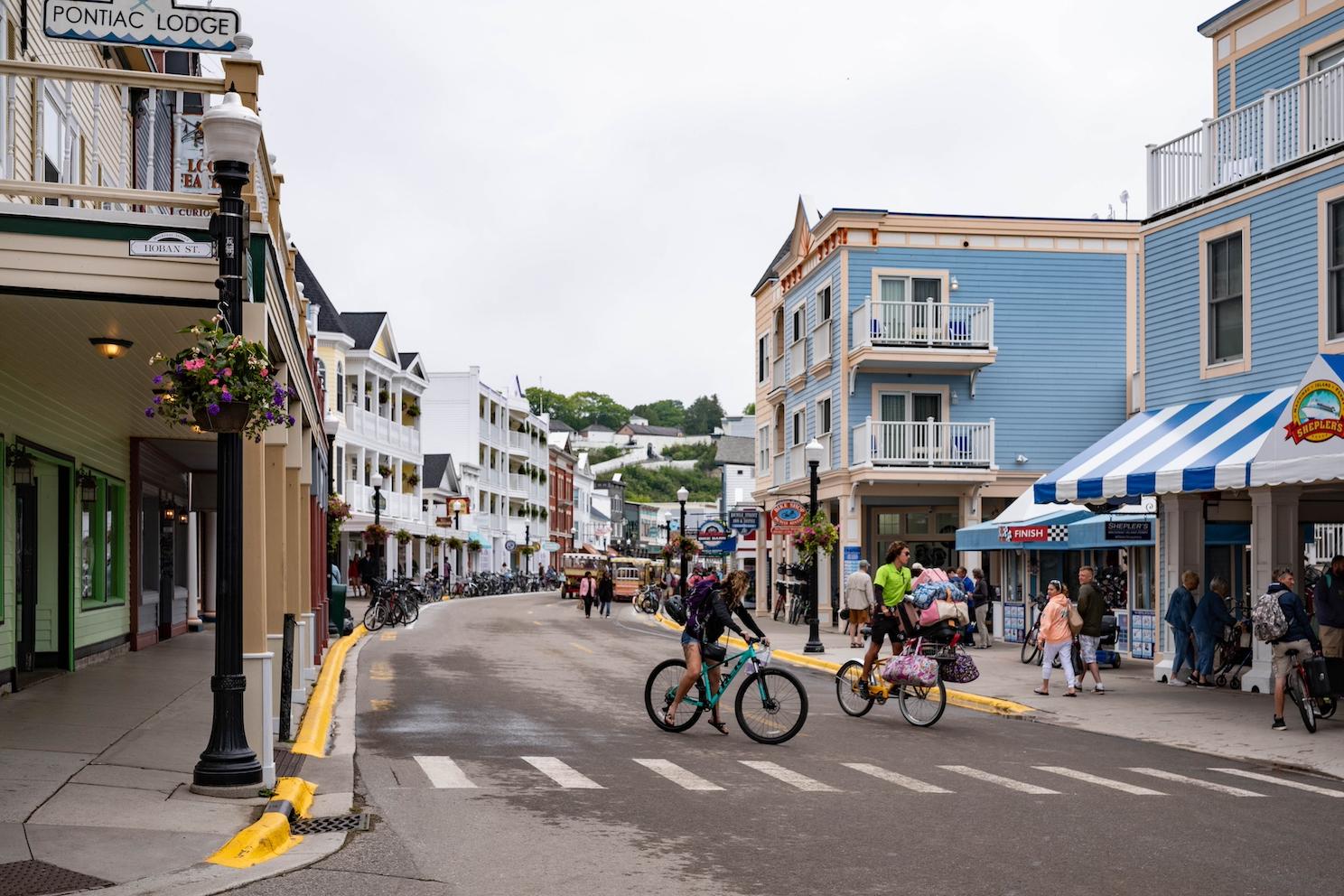
Bikers take to the streets of downtown Mackinac Island, Michigan, where cars were banned over a century ago. (Image: rboed/Wikimedia Commons)
This story about bike infrastructure is part of The Solutions Effect, a monthly newsletter covering the best of solutions journalism in the sustainability and social impact space. If you aren't already getting this newsletter, you can sign up here.
Born and raised in Michigan’s Upper Peninsula, I grew up visiting Mackinac Island, the first and only city in the United States with a 100 out of 100 biking quality score. Situated between Michigan’s peninsulas at the top of Lake Huron, the 3.8-square-mile island is home to over 70 miles of trails and the only state highway in the nation that bans motor vehicles. Visitors can rent one of the almost 1,500 bikes available to travel the 8.2-mile road, looping around the entire island without having to swerve for a single car, though they may need to move aside for a horse-drawn carriage or two.
Mackinac Island is an urban bicycle enthusiast's dream. Its bike-filled streets evoke a sense of whimsy, and as a child, I often wondered why more of the world didn’t operate this way. Bikes were so much more fun than cars! As an adult, I understand that level of bike prioritization was made possible by a century-old decision to ban cars on the island, a measure that’s essentially out of the question for large U.S. metropolises.
But big cities are making traction in positioning bike-filled streets as a way to meet their sustainability goals, improve public health and reduce traffic congestion. This year, the 10 largest U.S. urban areas included in PeopleForBikes’ annual bikeability ratings all scored above a 50. Scored on a zero-to-100 scale, the ratings are primarily based on bicycle access, road safety for cyclists and pedestrians, and availability of reliable data. The nonprofit bicycle trade association considers a score of 50 the critical tipping point where a city is building the momentum necessary to create a safe, low-stress route network that allows people to bike from home to all of the places they want to go.
In the 2025 rankings, 234 U.S. cities reached that point, up from just 33 in 2019, according to PeopleForBikes. Here’s how solutions journalists are following the momentum in major cities.
Denver, Colorado
Denver made headlines over the last year for its astonishingly successful e-bike rebate program, which offers a limited number of discount vouchers worth up to $900 for city residents who make less than the area’s median income. But you may be surprised to learn the city scored a 47 in this year’s rankings, landing it at the 268 spot for cities in the U.S. and 13th in Colorado. (It’s worth noting the average score across all cities in the rankings is 30.)
Dever’s score has slowly but surely increased over the last six years, now offering a growing network of 480 miles of on-street bikeways and off-street trails. As it works to get people out of their cars by becoming more bikable, the city introduced a rebate program so popular that the first-come, first-served vouchers are snatched up within minutes of the online portal opening every other month.
Over 9,000 Denverites have purchased subsidized e-bikes since the program began two years ago, Mother Jones reports. The city found rebate recipients ride their bikes an average of 26 miles a week, often year-round, meaning the program eliminates an estimated 6.1 million automobile miles and reduces carbon dioxide emissions by almost 190,000 metric tons each year. Many city cyclists say the rebates are the incentive they needed to finally purchase a bike. Though the city’s bicycle network is far from perfect, improving biking safety and connectivity is a current priority of Denver and the Colorado Department of Transportation. Read more.
Boston, Massachusetts
A new on-demand electric cargo bikeshare program is picking up speed in Boston. Founded by two locals, the startup CargoB lets people in the Boston area rent a small fleet of front-loading bucket bikes capable of carrying 300 pounds of cargo. Similar to other successful bikeshare programs, users unlock a bike for $2.50 via a smartphone app and pay an additional 25 cents per minute. The startup also offers annual passes and full-day and multi-day rental options.
CargoB already has 700 subscribers, and people are asking for it to expand, Reasons to be Cheerful reports. Right now, it rents out seven bikes and plans to launch up to 15 more by the end of the year. The founders hope to keep growing in and outside of Boston.
Although Beantown is one of few U.S. cities with a dedicated “Bike Mayor” tasked with making biking more accessible, the city has a long way to go to make safe biking routes available everywhere. It received a 35 in this year’s PeopleForBikes rankings, landing at 588th in the U.S. and ninth in Massachusetts. Read more.
New York, New York
New York City’s Central Park is perhaps the only urban place I’ve visited that is reminiscent of Michigan’s Mackinac Island, albeit much more crowded. Unauthorized cars were banned from the park in 2018, but the transition left the park in chaos. Each day, an incredible number of pedestrians, cyclists, scooter riders, and horse-drawn carriages at all manner of speeds make their way along roads created with only cars in mind.
Now, the city’s department of transportation and the Central Park Conservancy, the nonprofit steward of the park, are building new lanes designed for everything but cars, Bloomberg reports. Color-coordinated lanes designate sections of road for bikers and walkers. Some pedestrian lanes reach 19 feet wide, with 10 feet plus a narrow passing lane dedicated to bikes. The busiest road crossings will have bike-sized speed bumps and timed signal lights. While the changes seem to be working out so far, some say they aren’t enough, calling for better bike lanes outside of the park.
As it stands, New York City ranks 95th in the U.S. and fourth in New York state in the bikeability rankings with a score of 61. This year’s rankings also include the city’s five boroughs separately. Three of them — Brooklyn, Queens and Manhattan — made the top 10 for large U.S. cities. Brooklyn claimed the No. 1 spot for large U.S. cities — ranked 34 overall — with a score of 73. Read more.
Portland, Oregon
I often hear people reminisce about biking to school. By the time my generation reached that point, safety concerns and increased commutes made it a vanishing experience. A former school teacher from Portland, Oregon, is bringing it back, The Guardian reports.
Portland ranks relatively high on the PeopleForBikes scorecard, sitting in 98th place in the U.S. and third in Oregon with a bikeability score of 61. Its score has increased consistently since 2018, but the biking-to-school movement in Portland began well before that. In 2010, bike advocate Kiel Johnson started organizing “bike trains” to help elementary students get to school, citing the physical and mental health benefits of cycling.
The initial movement ended in 2012 but was picked up again in 2021 by former physical education teacher Sam Balto. Inspired by a video of a “bike bus” of students biking to school in large groups in Barcelona, he launched a bus of his own. Balto rode his bike to school, joined by students and parental chaperones on bikes along the way. Students loved the idea, and so did people on social media. As the buses gained popularity locally, videos of them garnered millions of views online. Now, Balto runs the nonprofit Bike Bus World, bringing bike buses to students across the globe. Read more.
Why the slow progress?
Alongside all of this momentum, we’d be remiss not to mention the downsides of the biking boom. Bicyclist fatalities are still increasing every year, according to the National Highway Traffic Safety Administration’s most recent data from 2023. Though cities are prioritizing bike access and new bike lanes, their streets were designed with cars as the first priority. Since cars still reign supreme, they’re not all building bike networks in the safest way possible. Building more protected bike lanes and dedicated bikeways is critical for the safety of those on the roads.
Cities also face increasing backlash for prioritizing bike infrastructure. Grand Junction, Colorado, built its first protected bike lanes last summer. The change required a local road to be reduced from two lanes of car traffic to one, and the accompanying traffic slowdowns prompted months of outcry from residents, Colorado Public Radio reports. In Oakland, California, communities raised concerns that new bike lanes were a sign of gentrification and wouldn’t do enough to encourage people to ride bikes without additional street improvements, Bloomberg reports. The city’s department of transportation listened to what residents had to say, updating plans to reflect their concerns and eventually winning a grant to begin street improvement work. Some of the lessons learned from that project were used to update the National Association of City Transportation Officials’ Urban Bikeway Design Guide.
Still, the cycling movement is gaining ground internationally as cities prioritize environmental and social sustainability. The PeopleForBikes rankings feature cities making significant progress around the world, including Paris, Brussels, Munich and Amsterdam. The Bicycle Mayor Network of over 150 cycling activists in 34 countries, including Boston’s, is another example. While not elected officials, the “mayors” advocate for local bicycling initiatives, engage with locals, and focus on bridging the gap between communities and governments. This kind of collective brain power leads to progress as cities help each other learn how to maximize the benefits and reduce the drawbacks.

Taylor’s work spans print, podcasts, photography and radio. She brings her passion for covering social and environmental issues through the lens of solutions journalism to her work as assistant editor.














